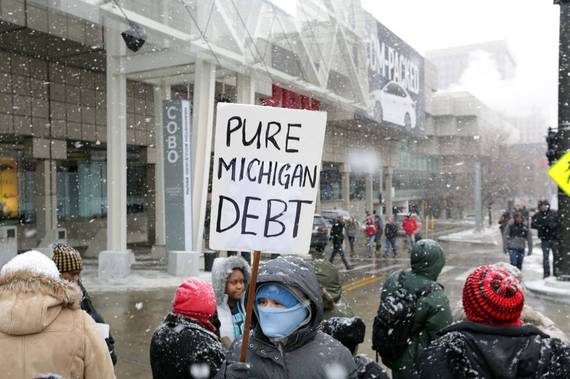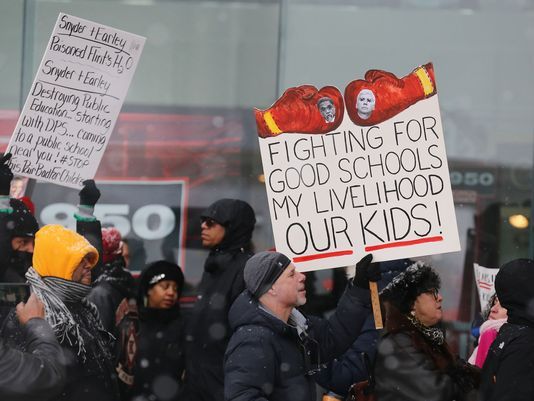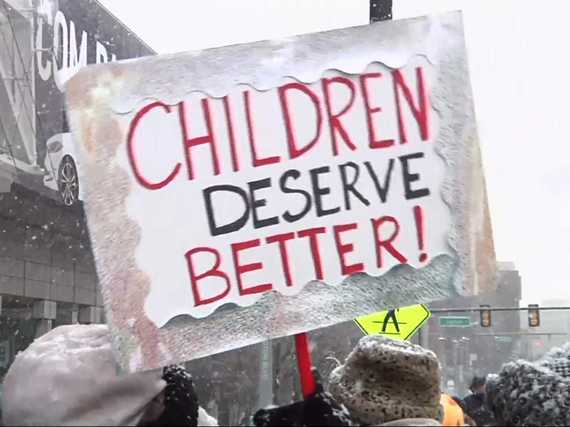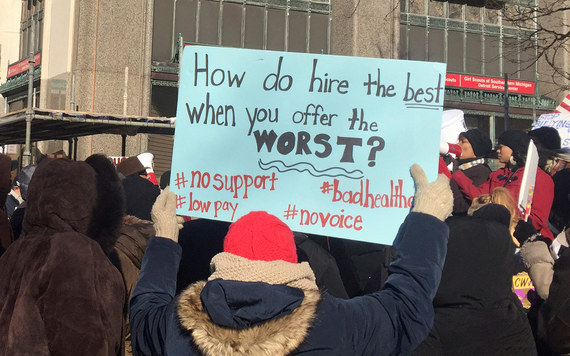The ongoing teacher protest in Detroit has drawn public attention to the horrific physical conditions in many of the city's public schools. Photos have circulated of toxic mold, mushrooms growing out of walls, evidence of infestation, and gym floors too warped to stand, much less run, on. Each one is a window into a complex tragedy of multilayered government neglect and a funding system that traps children in under-resourced schools. These conditions call out not just for emergency aid, but systemic reform.
In the 1880's, Upton Sinclair's book The Jungle depicted the deplorable conditions of the meatpacking industry in Chicago. In one memorable passage, he describes what happens to packing-plant waste:
"Bubbly Creek" is an arm of the Chicago River... all the drainage of the square mile of packing houses empties into it, so that it is really a great open sewer a hundred or two feet wide... Bubbles of carbonic acid gas will rise to the surface and burst, and make rings two or three feet wide... The packers used to leave the creek that way, till every now and then the surface would catch on fire and burn furiously, and the fire department would have to come and put it out.
The Jungle triggered a public outcry led that to real national action: the creation of the federal Food and Drug Administration, which was tasked by President Theodore Roosevelt to oversee private companies, and to drop the hammer on those jeopardizing the health of American citizens.
If only there were such sweeping federal protections when it comes to public schools. A completely arbitrary and fractured school funding system leads to conditions in many cities like Detroit have been allowed to worsen until the situation seems, now, almost irredeemable.
The bleak picture:
There's black mold in the classrooms of Detroit's Spain Elementary-Middle School, where more than 650 students are expected to learn. A recent health inspection found evidence of vermin infestation, including feces and carcasses, throughout the school. In this school, all but two students are African American, and the vast majority of the population relies on meals prepared for them each day within the decaying walls. There were 280 suspensions handed out at Spain Elementary-Middle School last year--that's 1 for every 2.3 students. Only 10 students in the entire school are meeting state standards in math.
The school's sorry state has attracted the attention of celebrities like Ellen DeGeneres and Justin Bieber, but these conditions extend well beyond this one school, and superstar fundraisers can't address the serious and systemic issues that gave rise to Spain's troubles. Who, then, is at fault?
It is certainly irrefutable that, due to years of poor financial management, the Detroit City school district finds itself in extreme debt. The district has taken out such large loans that currently, $3,019--nearly a quarter--of funding that the school district receives for each student goes immediately to paying off years of bad debt rather than to the classroom. There's little room in that equation for hundreds of millions of dollars in facilities repair--or even, apparently, for the small capital repairs would be required to, say, keep the toilets and sinks working in the girl's bathroom. The system's current debt, estimated to be $3.5 billion in short and long-term liabilities, is so enormous and complex, some estimate that it's increasing by $1 million every day. The system is now in a position of choosing between paying bills or paying teachers.
But we're missing a key point when we limit our focus to district mismanagement. There's a much larger system of institutional failures is letting down Detroit's children, both in the specific area of school facilities oversight and the general realm of education finance.
The city's responsibility:
The municipality of Detroit bears its own responsibility for the situation. In response to the teacher sick-outs and observed conditions in the schools, Mayor Mike Duggan ordered the inspection of all Detroit public schools in the city. This belated gesture only underlines how little oversight the city's health and building agencies have exercised over schools until now; so far, the Buildings, Safety Engineering, and Environment Department (BSEED) has turned up 433 code violations in the first 48 schools inspected, every one of which was missing its required annual Certificate of Compliance. Of those inspected, 10 schools so far have also been referred to the Detroit Department of Health--another city agency just now coming on the scene--and that department has reported 71 health violations to date within those 10 buildings. Each of these schools has also been given 30 days before the building is shuttered.
The city-level issues go beyond poor agency supervision. The struggles of Detroit overall, and the radical decline of property values in the city, have been well documented. Because property taxes form the foundation of all education budgets in Michigan (as in most states), in order to keep schools funded, the city's residents have had to levy extremely high rates as their tax base has shrunk. Detroit now taxes its property at 8.7% each year just to pay for schools. That's 47% higher than the tax rate paid by its wealthy neighbor Grosse Pointe, where the median household income is more than three times as high as Detroit's and where, it goes without saying, there are most likely no vermin carcasses under the desks.
Detroit residents really have no more money to spare for their schools, nor should they be asked to continue to tax themselves at a rate far higher than their wealthy neighbors.
The state's responsibility:

In the case of both the buildings and the funding, there's clear evidence of neglect at the state level. It turns out that teachers from Spain Elementary-Middle School have been writing for over a year to the Michigan Occupational Safety and Health Administration, but until very recently, they were told that the state did "not plan to conduct an onsite inspection at this time." (If the state had inspected, it would have found the health conditions that city has since identified as so hazardous that it has threatened to close the school within 30 days if the vermin, mold, and ceiling leaks aren't addressed.)
But the state hasn't only failed to respond to this crisis--it also helped to create it. Over half of Detroit's children live in poverty, and the school district certainly needs greater resources to meet student needs than a wealthy district like Grosse Point. Despite this, the state gives almost exactly the same amount per pupil to each district: $7,902 to Detroit and $7,911 to Grosse Point, according to the most recent available figures. When the needs of students in Detroit are far greater and the residents of the city are already taxing themselves at a far higher rate than their neighbors, it is incumbent upon the state to provide resources that recognize both the local resident effort to help their schools and the significant needs of DPS students.
The current state of facilities in Detroit isn't a one-off problem of mismanagement. It's a picture of a system that can't escape mistakes of the past, a city that's already taxing itself at a higher rate than its peers, and a state that isn't offering much help. We're witnessing an institutional structure that, at every level of government, abdicates responsibility, yet expects teachers and students to somehow excel within a radically broken--and broke--system.
In the 1880's, The Jungle triggered a real response. The government didn't just send firefighters to address the immediate crisis; it created a structural solution. No such systemic approach is being taken today in response to the endangerment of Detroit's children. Though these stories "catch fire and burn furiously" now and again, once the furor has died down, a fractured school funding system leaves many students in Detroit and across the country up the metaphorical filthy and flammable creek. It's time we get serious about school funding reform.



